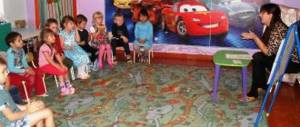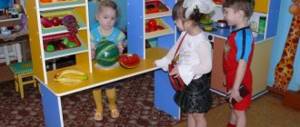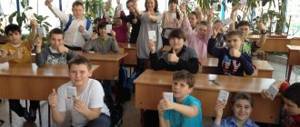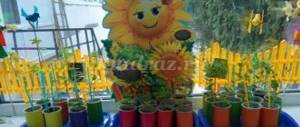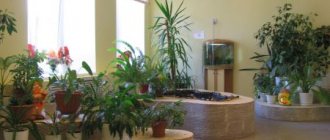Autumn excursion, 3rd grade
Methodological development of an autumn excursion for 3rd grade
Excursion in 3rd grade “Autumn has come to our schoolyard.”
Author: Svetlana Nikolaevna Matveeva,
primary school teacher, Secondary School No. 9, Ulyanovsk.
Description of work: I bring to your attention the development of an autumn-themed excursion. The material is intended for primary school teachers and teachers of extended day groups when conducting extra-curricular activities in the fresh air. This material is aimed at students of primary school age and can be used in lessons about the world around them. Seasonal excursions into nature have enormous developmental potential in the process of forming an ecological picture of the world among younger schoolchildren. Goal: observing autumn changes in nature. Objectives: - observe the signs of the onset of autumn in nature;
— develop the ability to distinguish the leaves of the most common species of trees, shrubs, and grasses; — develop students’ logical thinking, ability to compare and draw conclusions; — increase the level of environmental culture of students. Progress of the excursion
Teacher: Guys, today we are going on an excursion to our school yard. Gathering of children, departure to the school yard. Teacher: If the leaves on the trees have turned yellow, If the birds have flown to a distant land, If the sky is gloomy, if the rain is pouring, This time of year, tell me, what is it called? (Autumn).
Teacher: Speaking about autumn, the lines of Alexander Sergeevich Pushkin immediately come to mind. It's a sad time! Ouch charm! Your farewell beauty is pleasant to me - I love the lush decay of nature, forests dressed in crimson and gold! Teacher: Guys, look around! Autumn is indeed both a “dull time” and a “charm of the eyes.” Why do you think? Children's answers. Teacher: Today, being in nature, let's remember what other poems about autumn you know. Who can tell us them? Children read poems about autumn. Sample verses: Leaf fall, leaf fall, Yellow leaves are flying. Yellow maple, yellow beech, Yellow circle of the sun in the sky. Yellow yard, yellow house. The whole earth is yellow all around. Yellowness, yellowness, So autumn is not spring. V. Nirovich
The trunk is slender, the bark is dark, It was green all summer.
Autumn time has come, I put on a purple maple outfit. The maple tree bathed in the sun and washed itself with its palm. Red autumn has arrived. I burned all my palms. The rain extinguished the flame, the wind dried the branches. Yellow palms are flying towards us through the windows. A. Kulagina Teacher: Well done, guys! You read beautiful poems to us. Let's applaud! Applause to the readers. Teacher: Guys, if you listened carefully to our readers, you probably noticed the main signs of autumn, found in almost every poem. Let's remember them again and name them, while making the appropriate observations. Children list the main signs of autumn and observe them in nature. Teacher: Now I suggest working in groups of 5-7 people. We divide into three groups. Teacher: Guess the riddles. Each group is given one riddle. For the 1st group: Autumn has come to the city again, bringing leaf fall to us. A leaf similar to a crown of a spreading... (Maple).
For the 2nd group: The pillars are white, the caps on them are green. (Birch).
For the 3rd group: I took a walk in the park, I learned where the dawn grows. I looked up - she immediately became visible to me! The berries are burning brightly, They are looking at me! What a wonderful picture? - This tree is... (Rowan).
Teacher: Listen to the names of your teams: the first group is maple leaves, the second group is birch leaves, the third group is rowan leaves. Teacher: The first task for the teams is “Find your tree.” Each team needs to find its own tree in the school yard. (It is advisable that all the trees are nearby). The guys are doing the task. Teacher: Well done! All teams quickly and accurately identified their tree. Notice that each tree has a leaf attached to it. It contains information about the tree. You must read this short story and determine whether the information attached to your tree is correct. If not, then attach the information to the desired tree. (It is advisable to attach the sheets so that the tree and information about it do not coincide.) Information 1: This tree is the main inhabitant of Russian forests, distributed throughout the Russian Federation. From time immemorial it has been used as a medicinal and cosmetic product. Bark, catkins, leaves, juice - all these components have a beneficial effect on the human body. In addition, it is believed that this tree has a beneficial effect on the energy of the person who is next to it. (Birch). Information 2: The sap of this tree is tasty; in the old days sugar was evaporated from it. Many musical instruments are made from the wood of this tree, for example: clarinets, flutes. This tree has heavy and dense wood, strong and hard. When it dries out moderately, it swells and warps a little. This tree splits with great difficulty. In ancient Novgorod, this tree was a favorite material for craftsmen who made spoons, ladles, carved and turned vessels. Oars, knife handles, bearings and other critical parts of simple machines were made from it. This widespread use of wood is not accidental, since it is well processed with cutting tools. Leaves and shoots are used for medicinal purposes. Infusion and decoction of leaves also have a healing effect. An ancient folk remedy for cough: add 1 tablespoon of the sap of this tree to 1 glass of hot milk and drink. For a cut, apply clean crushed leaves to the wound. (Maple). Information 3: This tree belongs to the genus of deciduous frost-resistant shrubs and trees of the Rosaceae family. The name comes from the birds feasting on the fruits of this tree. There are more than 100 species of this tree in the world. (Rowan). Teacher: Well done, all teams completed the task. The next task is “Collect a proverb.” Each team is given an envelope. It contains words from a proverb about a tree. It is necessary to quickly and correctly arrange all the words to form a proverb. Next, the whole team read the proverb loudly and clearly. Sample proverbs: Without wind, a maple leaf won’t move. A lot of sap flows from the birch - for a rainy summer. For the enemy, birch is a threat. Late flowering of rowan - for a long autumn. There are a lot of rowan trees in the forest - autumn will be rainy, if there are few - it will be dry. Teacher: Okay. All teams completed the task very well. Let's move on. Next task: hug a birch tree with both hands, stand, close your eyes, think and continue the phrase “I feel...” . Teacher: Great, gain energy and positive charge. Now it's time to collect leaves for the herbarium. It is advisable that all your leaves be different. Children collect leaves. Teacher: Let's try to determine which leaves are in our hands. We define, lay out, clarify, consult, work together.
There will be a lot of berries - lights in the fall.
And a red rowan tree will give Marina Beads. Here is a maple leaf on a branch. Now it's just like new! All ruddy and golden. Where are you going, leaf? Wait! The pillars are white, the caps on them are green. Teacher: What tree is this riddle about? I look out my window, I see one tree. The red clusters are hanging, the birds want to eat them. The dress is lost, but the buttons remain? (Rowan).
Teacher: That's right, it's all rowan. Look how beautiful the grapes are on it. Rowan bunches are a delicacy for birds.
Teacher: When we return to class, we will definitely try to make such bunches from plasticine, and maybe some of you will want to make rowan beads. We play a little outdoors.
Then we go to school and take with us dry leaves for the herbarium.
And be sure to do work from plasticine “Rowan bunches or beads” during a technology lesson, class hour or in an extended day group. Tips for the excursion:
1. An excursion is not a walk, but a part of educational activities.
2. Before you go on an excursion, you need to carefully study the place. 3. Always try to stick to the topic of the excursion without being distracted by random questions. 4. It is better to talk on excursions only about what can be shown. 5. Long explanations should be avoided. 6. Tourists are not only listeners, but also active participants. 7. Try to skillfully and correctly show objects, while teaching listeners to look at them correctly: everyone should be able to see them. 8. Excursionists do not need extra fatigue; they will lose interest in listening to you. 9. Always remember to consolidate the excursion in memory through subsequent study of the material. 10. Get pleasure and positivity from communicating with children in nature!!! Teacher: (upon returning to class)
Autumn is walking in our park, Autumn gives gifts to everyone: Red beads for rowan, Pink apron for aspen, Yellow umbrella for poplars, Autumn gives us fruits!
(I. Vinokurov)
Let's all help ourselves to red apples!!! Thank you for attention!!!
We recommend watching:
Scenario for the autumn holiday in elementary school “Hello, autumn” Scenario for the game autumn program in elementary school. Autumn in the forest Extracurricular activity in elementary school on the topic: Autumn Extracurricular activity on the topic: Autumn for middle school students
Similar articles:
Autumn holiday in 3rd and 4th grade. Scenario
Gold autumn. Scenario for primary classes
Autumn festival in elementary school. Scenario
Autumn holiday in 1st grade
Scenario for the Autumn holiday in elementary school
